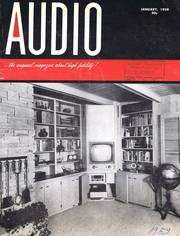Erläuterungen zu diesen US-AUDIO Seiten der 1950er Jahre
Die hier stehenden amerikanischen Artikel aus 1959 (aus der US-AUDIO) sind teilweise sehr gewöhnungsbedürftig, weil sie erstens aus einer längst vergangenen Zeit stammen und zweitens, weil dort in den USA ganz "anders" gedacht wurde als bei uns in Old Germany oder in Europa.
Vergleichbar mit unseren deutschen Hifi-Magazinen etwa ab 1962 ist jedoch, daß auch dieses Audio-Magazin ihre Anzeigen- Kunden und -Leser am Markt oder von anderen Magazinen (be- oder ab- ?) werben mußte. - Weiterhin sind die riesigen Dimensionen des amerikanischen Kontinents mit unseren hier in Europa nicht vergleichbar. - Ein Redaktions-"Trip" von New York nach Los Angeles oder Chicago oder gar in die Wüste nach Las-Vegas zu einer der CES- Audio- "Shows" war - auch mit dem Flugzeug - immer noch eine halbe Weltreise. Und jede Ausstellung oder "Messe" wurde als "Show" deklariert. Und natürlich, in USA musste alles "Show" sein, um beim Publikum einige Aufmerksamkeit zu erzeugen.
.
Die monatliche Kolumne - Editors' REVIEW - das Editorial
POWER RATINGS vs. DISTORTION
Considerable food for thought was contained in a recent announcement in the columns of "Home Furnishings Daily" telling of the intent of the "Electronic Industry Association" to adopt a power rating figure based on a distortion of either 5% or 10%. In this meaty announcement, it appears, the basic difference between real high fidelity as represented by the entire component industry, and "hi-fi" as presented in the daily newspaper advertisements with various complete systems being offered anywhere from $49.95 up, is brought out.
"Wir" haben immer noch keine Standards ....
Since no performance standards have been accepted by which the true quality of reproducing equipment can be assessed, who is to say that the stuff labeled "hi-fi" is not high fidelity?
Even in the area of real high fidelity - components - neither the manufacturers individually nor the "Institute of High Fidelity Manufacturers" (IHFM) have attempted to set performance standards; the amplifier and tuner standards that have already been adopted by the IHFM refer only to the methods of measurement and the ways in which the results of the measurements may be set forth. Not once do the standards specify a minimum performance to entitle the product to be called "high fidelity."
The IHFM und the EIA and the percentage
In attempting to correlate the standards of the IHFM with the EIA - a practice that is common throughout all industry - it became apparent that the idea of one per cent distortion was not at all acceptable to the EIA, whereas practically all high fidelity components are rated at the one-per-cent point, some even lower.
For years, the tube handbooks have rated output tubes at 5%, but with the better designs of feedback amplifiers tubes are worked to about the same outputs with distortions not exceeding one per cent.
Es ist vergleichbar mit dem PS-Rennen bei den Autos
The horsepower race among automobile manufacturers is quite closely paralleled by the radio, TV, and "hi-fi" manufacturers. Whereas many fine component amplifiers are rated at, for example, 30 or 40 or 50 watts, many of the other amplifier products on the market employ much higher figures in rating their equipment.
No one who has ever built an amplifier or who has ever made any measurements on one will believe it when he reads of a 40-watt amplifier which employs a pair of 6V6's, but such statements appear in ads at times.
Diese "Music Power Output" Angabe ist Unsinn
Even the rating of "Music Power Output" which is specified as the "greatest single-frequency power that can be obtained without exceeding rated total harmonic distortion" becomes a large figure with good equipment, and if everyone used the same method of measurement the performance of different amplifiers could be compared fairly.
The term "Peak Power Output" gave a higher numerical figure to use in advertisements, since it is by definition exactly two times the normal power output. However, this rating is not included in the new standard. If some manufacturer should decide to use "Peak Music Power Output," he would have some astronomical figures to advertise, particularly if his rated distortion were to be 10%.
Wir brauchen vergleichbare Messmethoden oder Vorgaben
Since the power output figures have achieved an importance all out of proportion to their actual meaning with respect to quality of reproduction, we believe that a brand new term should be employed by all component high fidelity manufacturers to rate their amplifiers, and this rating would be in -
HI-FI WATTS
which would, by definition, be the music power output, in accordance with the IHFM Standard, at 1% distortion.
This would automatically differentiate ordinary phono equipment from true high-fidelity equipment, and ratings given in Hi-Fi Watts would almost invariably indicate the quality of equipment that was being described in the ads.
Not everyone needs 50-watt amplifiers, but even when listening at one-tenth or one-quarter watt levels, the critical listener still wants his distortion held down to less than one per cent. And that there is a difference practically anyone who has listened to professional-quality equipment will agree.
STEREO vs. HIGH FIDELITY
The fact that stereo has burst onto the advertising pages of the daily papers has made stereo the one thing that attracts people, and we believe that the component industry has been a little lax in allowing the importance of stereo to overshadow the real end object of high quality sound reproduction - high fidelity. Anything can be stereo, as we all know from the ads, but only high quality equipment will sound good. It is as though the automobile industry decided to push the station wagon as the greatest thing in the world. Anybody can make a station wagon, but only Rolls Royce can build a Rolls Royce.
SPEAKING OF ROLLS ROYCE .......
In case you didn't win the one Shure Brothers offered in their recent contest, you may at least be interested in who did. Kenneth E. Shutts, of Chagrin Falls, Ohio, was the lucky man. But anyway, try again next time.
AES CITATION
While we realize that it is not considered in the best of taste to blow one's own horn, we also realize that Audio readers are not likely to see any mention of it elsewhere. On the occasion of its Eleventh Annual Banquet, October 8, the Audio Engineering Society honored us with a Citation
"in recognition of the contributions of
Audio magazine to the education of the
audio fraternity under our editorship."
We are indeed pleased, and we trust we may continue to enjoy the esteem of the Society.
.


